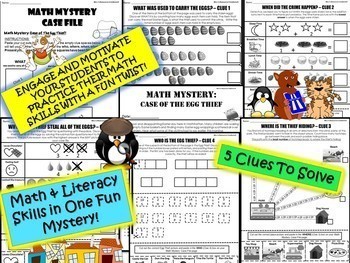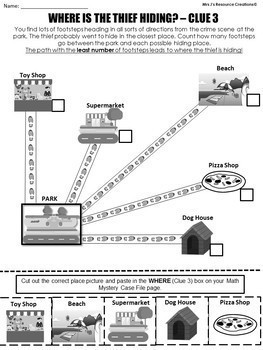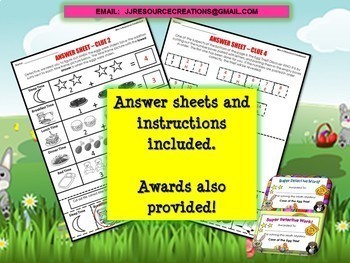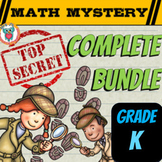Kindergarten Easter Activity: Easter Math Mystery - Case of The Egg Thief
- Zip
- Google Apps™

What educators are saying
Also included in
- Math Mysteries COMPLETE collection for the Kindergarten range. This complete math mystery bundle contains all of my math mysteries for Kindergarten to date! There are not as many math mysteries for this age group as in my other grade packs. However, if I create any more of this series in a KindergarPrice $46.40Original Price $58.00Save $11.60
Description
This Easter Math Mystery will engage and motivate your students during math time. 5'Ws Mystery Structure. In the Case of The Egg Thief, students must use their math skills to discover five important clues about the case: who, where, when, what, and why. Students must cut out the picture answer on their clue sheet and paste it into their Mystery Case file until all five have been completed.
⭐A video hook sets the stage for engagement! Check out the video hook in the preview section.
⭐A bonus ENDING VIDEO clip is included to celebrate finishing the mystery.
(Please note: The videos now come with voiceovers to read the story).
Preparation
Easy prep! You can print and go or go paperless with the new Google Slides option provided to complete the worksheets digitally.
This fun detective story also encourages literacy skills. Students must read simple sentences/phrases and match the information given with a text picture stencil to present on their mystery case file.
You can choose to use this resource in a number of ways. Some suggestions are:
• Complete one clue page daily as part of daily math practice or mental math warmup.
• Use as an early finisher task for fast/advanced students.
• Homework practice (1 page per day or week)
• Complete all at once as a whole class (guided/groups/pairs/independently)
⭐Math Skills included in this Math Mystery⭐
• Clue 1 (WHAT) – Counting and comparing (less than 20)
• Clue 2 (WHEN) – Addition with pictures (less than 10)
• Clue 3 (WHERE) – Counting and comparing (less than 20)
• Clue 4 (WHO) – Ordering numbers – cut and paste (1-14)
• Clue 5 (WHY) – Subtraction with pictures (less than 19)
EXTRAS
• A Literacy Extension Activity for optional use post-investigation (Write a Letter to the Easter Bunny)
• Answer Sheets
• Printable awards to give to students who solve the mystery!
The Case of the Egg Thief Math Mystery is also available in the following grade edition packs:
- Easter Math Mystery: Case of the Egg Thief (GRADE 1)
- Easter Math Mystery: Case of the Egg Thief (GRADE 2)
- Easter Math Mystery: Case of the Egg Thief (GRADE 3)
- Easter Math Mystery: Case of the Egg Thief (GRADE 4)
I hope your students enjoy it. Please do not hesitate to email me at JJResourceCreations@gmail.com or use my store Q & A if you need help or have any questions when using this resource.
Thanks!
Mrs J.
>>⭐ CLICK HERE to follow my store⭐ <<
This is a different format from my other math mysteries. This is a new structure that I hope will work well with Kindergarten students. If you would prefer something more challenging or would like math mysteries for other grades/skills you can find more in my store.
TRY A FULL FREE MATH MYSTERY HERE (GRADES 1 - 6 DIFFERENTIATED BUNDLE)






